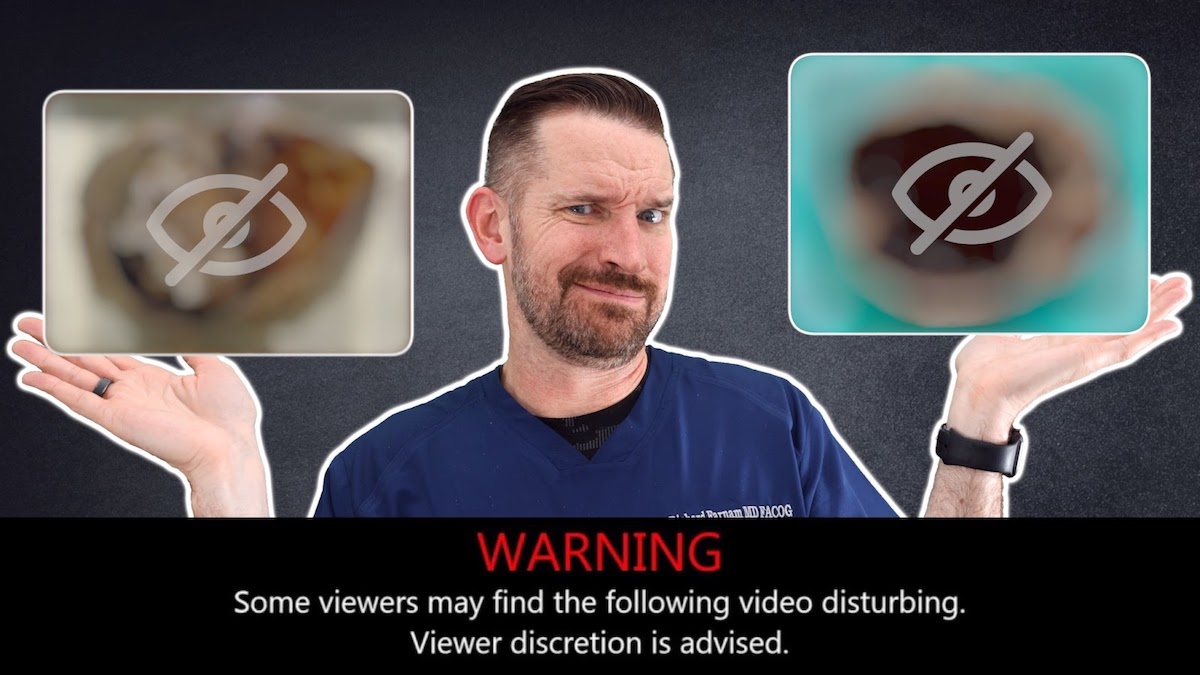Welcome back to the Doctor Rich channel! Do you have a fallen bladder, or vaginal prolapse, or a cystocele? And did your doctor tell you you need a mesh repair? Is there a non-mesh repair? Stick around and find out!
Don’t have time to read this post? Watch the video here instead!
Hi, I’m Doctor Rich and my passion is to provide every woman with practical knowledge about the world of women’s health.
We’ve talked about mesh repair sacrocolpopexy in a prior video.
[clip from the Sacrocolpopexy video plays]
“A different approach entirely can be done with a vaginal sacrospinous fixation. So what in the world is a sacrospinous fixation? Stay tuned for our next video to find out!”
Doctor Rich:
So as a urogynecologist, a big part of what we do is treat prolapse. Now, this is when one of pelvic organs falls into the vagina — and actually can push the vaginal skin outside of the body. It’s very uncomfortable, but it’s actually very common — about a third of women will have prolapse during their lifetime.
About 18% of all women will have surgery for prolapse. So there are different options — one being mesh repairs (which we’ve talked about in my sacrocolpopexy video series). This is the gold standard and has the highest success rate. And it’s specifically useful for women with advanced stage prolapse or very young age.
So what are the risk factors for prolapse? Well, the most common are obstetrical risk factors which are:
- the number of vaginal delivery
- instrumented deliveries (with forceps or vacuums)
- prolonged labor
In addition:
- hysterectomy is a risk factor
- smoking
- jobs that require heavy lifting
All of these things are going to increase your risk.
So how would anybody even know that they have prolapse? Well, other than feeling a physical bulge, sometimes this is described as sitting on a ball or “During the shower, I felt something down there.”
It could just be manifested by bleeding, or a discharge, or sexual pain, or constipation. You can also check out our last video where we talk about recurrent urinary tract infections possibly being a symptom of a fallen bladder.
Now, sacrocolpopexy and the sacrospinous ligament fixations are what is called an apical repair — or they suspend the top of the vagina. There is a tendency for some providers to only repair the bladder. It’s also important to understand that a bladder rarely falls by itself without also having apical prolapse — or the top of the vagina (or the cervix or the uterus) also coming down. So the top of the vagina needs to be addressed at the time of a bladder lift. In fact, if someone has a hysterectomy and they have preexisting prolapse, if that suspension isn’t done at that time — they have a thirteen times higher risk of needing bladder surgery in the future. So one of the apical suspension surgeries (either sacrocolpopexy or sacrospinous fixation) really needs to be done at the time of the bladder lift or the hysterectomy to maintain the support of the pelvis.
So we’ve talked about sacrocolpopexy in a number of other videos before. There’s a surgery called uterosacral vault suspension, today’s topic is sacrospinous fixation, and then there’s a surgery that basically removes the vagina called colpocleisis.
Today, we’re gonna talk about sacrospinous fixation. The great thing about the sacrospinous fixation is that it’s a surgery that’s done through the vagina — so there are no incisions! Now, this is particularly important in patients who have had multiple prior surgeries — maybe an abdominal hernia mesh, or open surgeries, or colostomy. All of these patients who’ve had prior surgeries are at risk of injury to those organs every time you have another surgery. So the sacrospinous fixation is done through the vagina below the level of peritoneum — so you never enter the abdominal cavity and you avoid (totally bypass) all of that scarring during your surgery.
Two other notable advantages of the sacrospinous fixation are the fact that it can be done under spinal anesthesia (instead of just totally going to sleep as you would have to for an abdominal repair or a sacrocolpopexy). Another advantage is it typically takes much less time to perform than a sacrocolpopexy. So another other benefit of the sacred spinal fixation is that it doesn’t use mesh. The top of the vagina is directly sutured to the ligament, or it is suspended using a biologic membrane. But mesh is not used for this repair.
Now it’s important to understand that mesh is very commonly used in surgery for both prolapse and incontinence. It’s very safe and effective, and you can check out this video here for more information about the good mesh and the bad mesh.
There are simply some patients that are not good candidates for mesh:
- patients who have had a mesh complication or know someone who has
- patients who have autoimmune disease
- smokers that are going to have delayed wound healing
- some patients with chronic pain
For patients like these, mesh is not a good option. And so this allows us the ability to provide a good, long-lasting, durable repair — without the use of vaginal mesh. There can be complications with sacrospinous fixation (as with any surgery!). The risk of complications are similar with all the prolapse repairs.
One specific complication is it is LITERALLY a pain in the butt. So some patients will get an achy sensation at the point of fixation (on their butt). This classically will last for a day or two, a week (sometimes six weeks) — but almost always universally resolves. If it doesn’t resolve, there is a risk of nerve entrapment — which should be addressed — but this is a very rare complication.
Make sure to check out our other video on sacrocolpopexy, which might be the best repair for you — particularly if you have advanced stage prolapse.
Thanks for sticking around to the end — hopefully this was helpful! Make sure you like and subscribe. Also — watch out for future content on the other two prolapse repairs we mentioned: the uterosacral vault suspension and the colpocleisis.




